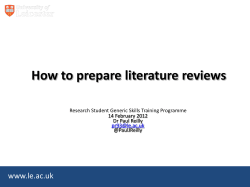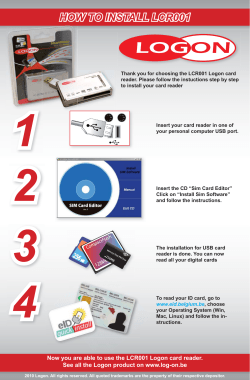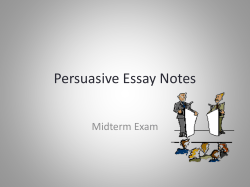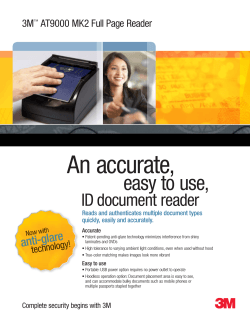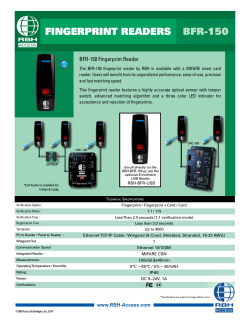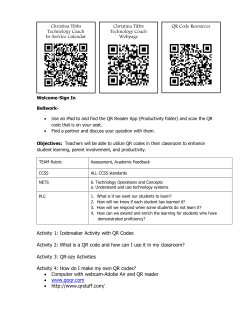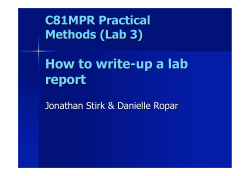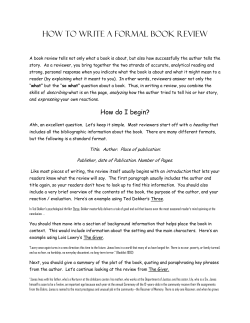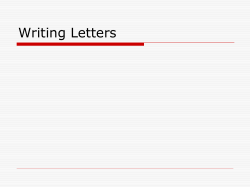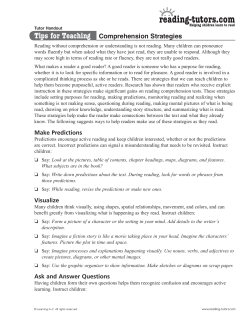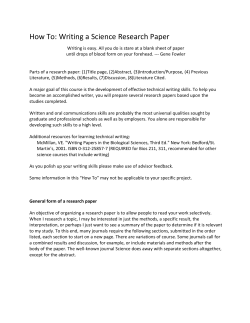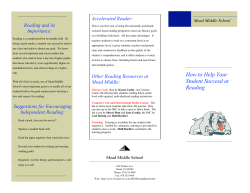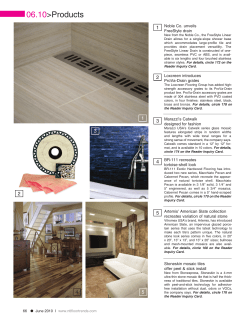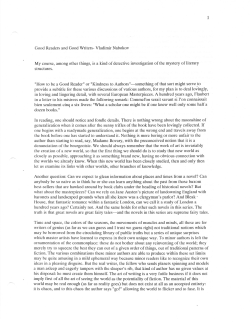
How to Write A Persuasive Business Letter F
How to Write A Persuasive Business Letter FOX & COMPANY, INC. “Put it before them briefly so they will read it, clearly so they will appreciate it, picturesquely so they will remember it, and, above all, accurately so they will be guided by its light.” – Pulitzer Published for the Clients and Friends of Fox & Company, Inc. Chester, Connecticut © 2006, Fox & Company, Inc. Page 1 G ood letters are good for business. Here are some simple rules on how to write an effective business letter. 1. THINK FIRST Before you write, determine the objective of your letter. What is it exactly that you want your letter to make happen? Plan every point you are going to make. • • • • Make a scattergram of all points. Write a zero draft. Write 1st draft. Write final draft. 2. STAY ON TRACK When writing a letter, don’t ramble. (Which is a good rule to remember while you are talking). Stay on track. Your letter can be long, and that’s OK. Don’t confuse your reader or readers by drifting off your original track. 3. REVIEW BEFORE SENDING Read your letter over, and for critical letters read aloud. Make sure your letter has all the facts that your reader needs to decide to do what you want him to do. Be sure you have asked your reader to do what you want him to do. (This simple rule is key to getting a sale or to getting anything done, yet is rarely followed.) Page 2 4. GET TO THE POINT! If your main point is not crystal clear, write it over. It is better to invest in a rewrite, then to salvage a misunderstanding or squander resources in a failed message. This is applicable to advertising headline writers. 5. MAKE YOUR LETTER EASY TO FILE If you want your reader to file your letter, write about one subject. 6. REPLACE “I” AND “OUR” WITH “YOU” AND “YOUR” Business readers are interested in their problems, not yours. Don’t talk about yourself (which is what you do when you use “I,” “we,” and “my”). Instead talk to your reader. Write, “You will receive,” instead of “I will send.” Write, “Your room will be cool and comfortable,” instead of “Our air conditioners have 12,000 BTU’s.” This is also a good rule for salespeople. If you say “you” instead of “I” your sales will increase by 20%. And this is an excellent rule for all those limited advertising headline and copy writers whose ads brag, “We are the most reliable… we are the most dependable… we make a difference… we are the most boring company in our industry.” Page 3 7. USE ACTIVE AND ACTION VERBS The easiest way to improve a letter is use active verbs. Change, “In accordance with our policy, it is expected from all company drivers that all company trucks will be returned clear and free of road grime,” to “Wash your truck before going home.” Put action in your letter everywhere possible. 8. MAKE YOUR LETTER EASY TO READ Use simple, declarative sentences. Put the subject first, the verb next, and the object last. Instead of writing, “Our product has been accorded general acceptance throughout the industry,” say, “Most customers like Aunt Amy’s Lemonade.” The “Aunt Amy” sentence reads easier, hits faster, and is remembered longer. 9. PAINT PICTURES! Your letter should be visual. Help your reader see what you want her to do. Which of these sentences is more persuasive? “After installation, our triple-strutted reinforced pool will afford you and your family years of enjoyment.” or, “Play water volleyball, or just float with a drink, in your new swimming pool.” Page 4 10. EXPRESS, DON’T IMPRESS Don’t send your reader to the dictionary; he won’t go. Save your vast vocabulary for a college faculty cocktail party. Readers aren’t impressed by your fancy words or technical knowledge. Your reader should not have to know the meaning of “avuncular, thixotropic, or HTML” to know what you want him to do. (All three of these words appeared in recent communications!) Don’t write, “Our wine is clarified using diatomaceous earth.” Instead say, “The wine is crisp and clean and delicious.” 11. JUNK THE JARGON Jargon unsells. Only use words you know your reader or readers will understand. Jargon is not only tech-talk, it is the intalk of an industry. For example, “cut and drag” means one thing to a computer jockey, but it means something completely different to a carpet layer, to a paste-up artist, or to a slaughterhouse butcher. Anything that can be misunderstood, will be misunderstood. Knowing the words your reader will understand means you must know your reader or customer. This is another basic rule for all marketers. 12. YOUR READER CAN SEE YOUR SMILE OR FROWN Write your letter with a smile on your face, and you will be more persuasive. You catch more flies with a sweet smile than a sour frown. Page 5 13. FRIENDLY LETTERS MAKE FRIENDS Why is it that the same person who writes a chatty, enjoyable letter to a friend will, in a business mode, become stilted, windy and sterile? Don’t be so businesslike. Your letters are supposed to make friends for your company, and to do that write in a friendly way… even when trying to collect late payments. 14. TO BORE IS A CRIME Especially today, with the blizzard of messages competing for your reader’s interest, you must be interesting. We received a letter the other day, and immediately called the police to have the writer arrested for attempted murder: he tried to bore us to death. Make your first sentence interesting. People will read long interesting letters. They won’t read short dull letters. 15. SLANG AIN’T ALWAYS BAD If Shakespeare and Thomas Jefferson could use slang, so can you. Jazz up a letter with the lingo of the times, and your letter can be more conversational and engaging. “The problem is a biggie, but if we noodle out some ideas the solution will be a breeze.” 16. DITCHÉ THE CLICHÉ A recent letter started with the cliché, “Pardon my pun, but…” The letter went to the recycle box. A message to that writer: heed Othello and “get thee to a punnery.” Page 6 17. BUZZ THE BUZZWORDS How sick are you of “paradigm shift” and “out-ofthe-box” and “reengineering?” (Do you and your significant other have synergy? And how dysfunctional is that passive/aggressive doggy in the window?) You want your reader to yearn, not yawn. 18. SELL YOUR BEST FRIEND FIRST You can’t sell your product until you totally believe in its purpose. Write a letter to a friend, or to yourself, and see if the letter persuades. Another check on a good letter: would you send a copy to someone whose judgment you respect? 19. PLAN YOUR TWO-MINUTE DRILL Excellent football teams doggedly practice a twominute drill designed to maximize the number of plays called in the least amount of time. If you met your best prospect in the airport and had twominutes, or 30 seconds to sell him, what would you say? If you had to give a two-minute talk to a room full of prospects, would you plan and write and rewrite the speech, or would you wing it? The two-minute speech that goes to the same prospects by mail should get the same kind of planning. And that’s true for today’s telephone answering machines. If you say something compelling, which benefits your prospect, she will call you back. Page 7 20. “PRODUCT X IS GREAT FOR YOU AND EASY TO GET” Your letter will persuade if you tell your prospect, in blunt, interesting terms, what great benefits “Product X” will give him, and how easy it is to get. “Lose ten pounds in ten days, or your money back. Call 800-LOSE-FAT!” Or, Dear Mr. Plumber: There is a new, but proven, way for you to increase what you charge customers for service calls… and make them happier at the same time! The secret is to sell dry basements or warm showers, not just a fixed pipe or a new water heater. If you are interested in how to increase your income, and how to build your customer base, please look over the enclosed video pamphlet entitled “Money Magic for the Professional Plumber.” The video is $39.95, probably what you are charging for a service call today, but half of what you will charge after watching “Money Magic.” To get the video either call 800-PLUMBER (800-758-6237) or fill-out the pre-stamped interest card. Sincerely yours, Joseph Waters Certified Master Plumber p.s. Call now, and you will be increasing your income within 48 hours. Page 8 21. GRAMMAR, PLEASE! Poor grammar is like poor manners: it signals insensitivity. Grammar makes language clear. If proper grammar “interferes” with your message it is likely that your message is fuzzy. Use punctuation! Punctuation makes sentences easier to read and to understand. It’s fine to use long sentences, but break them up with commas or colons… or with dots and dashes. Buy and read the book Elements of Style by Strunk & White. It’s short and wonderful. 22. NEVER WRITE A NASTY MEMO OR LETTER Write the letter when you’re mad, but don’t send it. Challenge yourself to find a way to make the object of your ire a friend or customer. The angry letter rarely persuades. 23. OPEN UP YOUR LETTER Vary the look of your letter. Long, crammed paragraphs are intimidating. Short, open paragraphs are easily digested. Bullet lists clarify complex topics. When you change thoughts or ideas, start a new paragraph. If your letter looks easy to read, it has a better chance of getting read. Page 9 24. WRITE WHAT’S IN IT FOR YOUR READER Show the reader how he or she will benefit by doing what you want them to do. Ask yourself, “Why should this person be persuaded?” Then write the answer. 25. PERSONALIZE YOUR LETTER SOMEHOW Put something of yourself in every letter you write. Your letters will be warmer, more acceptable, more impactful. One way to personalize a letter is to write the way you talk . . . with crisp editing. Another way is to send handwritten notes. 26. VERY ??? Drop “very” and improve your sentence. 27. DON’T BOAST. GIVE FACTS. Give the facts and let the reader decide for herself if your product is the fastest, greatest, lightest, smoothest and so on. Instead of saying, “Our product is the most reliable,” write, “This product turned on and off 112,000 times without a failure.” Don’t say, “Our delivery record is the best in the industry.” It is better to write, “74 of 75 deliveries per day are delivered before 10:00 AM.” State the facts. The customer will add the superlatives. Page 10 28. QUOTE SOMEONE “The product changed my life,” explained Ruby Holliday. “I’ll never be alone on a Saturday night again… unless I choose to be.” Does this quote increase your interest in the product? Quotes in letters make them easier to read, more interesting, and add third-party endorsement for credibility. Most people never think of using quotes in a letter. Try it. It works. 29. DOLLARIZE THE BENEFITS Quantify in dollars how much money your customer will get or save. Always be specific: tell your story using exact percentages, number of pounds, miles, yards of cloth. The line, “This seal will reduce your tractor trailer maintenance costs by $.70 every 1000 miles,” dollarizes the savings a trucking company can save with the seal. 30. ASK AND YE SHALL RECEIVE End your letter with an action recommendation. Tell your reader exactly what to do. “For information on how to enhance your product innovation and to leverage your products around the world, call Fox & Company at 860-677-4318.”
© Copyright 2025

